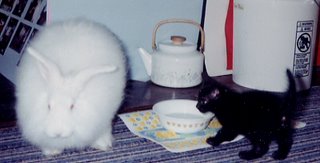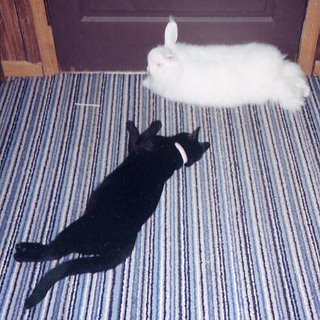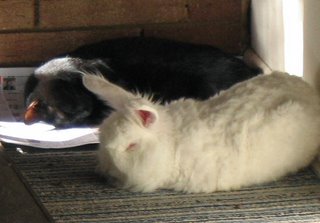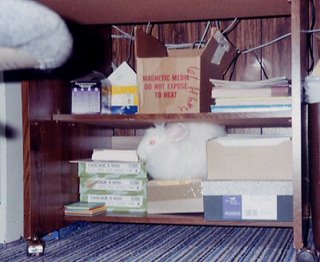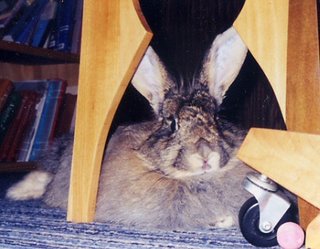By
LeighAngora is considered a challenge to spin. It is slippery, flyaway, and sticks to everything. That is why it is often blended with wool, especially when first learning to spin it. It is a scrumptious addition to any fiber, though I would consider it a waste with something too coarse.
If you are spinning it for the first time, a fairly fine wool is a good choice to blend it with. The best choice is something which is the same length as the Angora you are working with, as longer fibers tend to be pull out first during the drafting process, leaving the shorter fibers to be spun at the end of the rolag or batt.
I've never woolcombed Angora, but for carding, fine carders like cotton carders or the finest carding cloth available for your drum carder works best (at least 125 tines per inch) works best.

I also purchased a brush attachment for my drumcarder, a Fricke (now Strauch) Petite, as it helps keep the flyaway fibers under control.
Sharon mentioned experimenting with blending angora, and I did a lot of that too. I always found that my biggest difficulty was in getting an evenness of blend throughout the entire sample. For me, that meant weighing out the two fibers I wanted to blend, splitting and mixing up the batts, and running them through the drum carder for about 4 or 5 passes.
When it comes to spinning straight Angora, I don't do any of this. As in most things, I like to take the simplest approach. For me, that means simply spinning it by the handful, just as it is.

First I "tease" the fibers by gently pulling them apart by hand. No clumps in the fiber should mean no lumps in the yarn!
A towel in my lap is always essential to keep the stray fibers off of my clothes. I've heard that silk is the best for this, but mostly I just use an old towel.

Like everything else, this takes practice, but once you get the hang of it, it is easy to draft from the mass of fibers. I usually use a large whorl and treadle slowly to keep the greatest amount of control. If I've teased it well and there are no short bits or VM, then it drafts well into a smooth, even single.

Kathy mentioned putting Angora in the freezer to help tame the flyawayness. I've never tried this, but of course, I don't have the luxury of a large freezer! I do find that dryer sheets work wonders for flyaway Angora fibers. It works to hold the web of fibers within a dryer sheet and draft out from that. I always kept dryer sheets around when I groomed and clipped my bunnies too. In fact, I would start by rubbing them down with one! Just rubbing my hands with a dryer sheet helps any time I'm handling the fluffy stuff.
One of the biggest challenges to spinning a 100% Angora yarn is the fact that it is so smooth and slippery. This has to do with the structure of the individual fibers. Sheep wool is easier to spin because the fibers are covered with microscopic scales (kind of like a snake's skin) called cuticle scales. These grab onto one another during the spinning process so that the fibers "stick" together to create the yarn.
The cuticle scales of Angora are smaller, smoother, and fewer in number than sheep's wool. On the one hand, this accounts for the superior softness of Angora, but on the other hand, it also accounts for it's tendency to unspin itself and shed from the yarn or garment. The soft "halo" effect which develops ("blooms") with handling, is a lovely, characteristic feature of Angora, but the shedding is not. The spinner can do two things to help counteract this, the first is by adding
lots of twist. The tight twist will help trap the slippery fibers in the yarn.

The second thing has to do with the treatment of the yarn after spinning, which I'll have to put into another post.
Before I close though, I do want to respond to
Valerie's comment that I spoke of
my bunnies in the past tense. Sadly this is true. One by one they crossed the Rainbow Bridge, except for Miss Ivy. When we moved into smaller quarters in the city I found a country home for her with another spinner, where I felt she could be happier.
It's hard to not think of myself as a "Bunny Mom" anymore. I think that's one of the reasons why I chose what I did for my logo:

 This first skein is the straight Bowmont. My singles measured 66 WPI and the 2-ply is 32 WPI. This is amazing for me, and as I spun it I was reminded why I don't usually spin a fine yarn; it takes a long time!
This first skein is the straight Bowmont. My singles measured 66 WPI and the 2-ply is 32 WPI. This is amazing for me, and as I spun it I was reminded why I don't usually spin a fine yarn; it takes a long time! My rolags looked like punis, don't they? But my fiber length for this skein was about 1 inch. These were spun long draw.
My rolags looked like punis, don't they? But my fiber length for this skein was about 1 inch. These were spun long draw. The blend is about 2/3 Bowmont to 1/3 Angora and it has a lovely hand. I abused the yarn to full it, just like I showed you in this post. The finished yarn is slightly bumpy and measures 26 WPI. I have 43+ yards.
The blend is about 2/3 Bowmont to 1/3 Angora and it has a lovely hand. I abused the yarn to full it, just like I showed you in this post. The finished yarn is slightly bumpy and measures 26 WPI. I have 43+ yards.



















